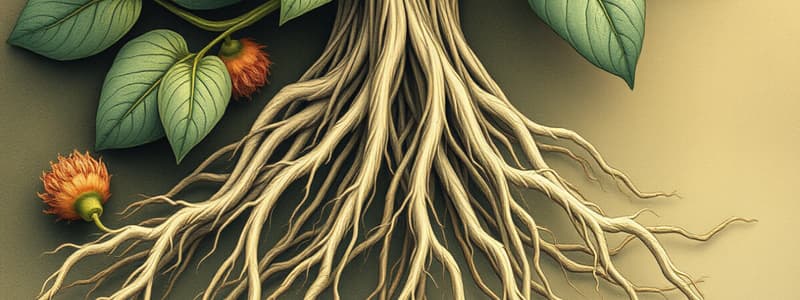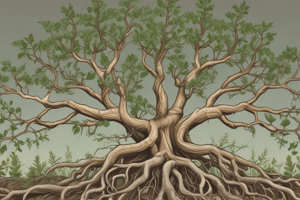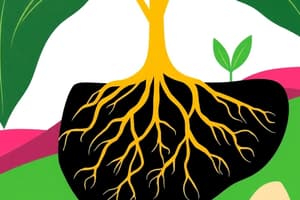Podcast
Questions and Answers
Terminal buds are responsible for the elongation of the stem.
Terminal buds are responsible for the elongation of the stem.
True (A)
Roots do not play a role in vegetative propagation.
Roots do not play a role in vegetative propagation.
False (B)
Xylem is the tissue responsible for transporting food in plants.
Xylem is the tissue responsible for transporting food in plants.
False (B)
Axillary buds can develop into branches if they are sufficiently distanced from the terminal bud.
Axillary buds can develop into branches if they are sufficiently distanced from the terminal bud.
The internode is the length of the stem between two nodes.
The internode is the length of the stem between two nodes.
The petiole is a stalk that connects leaves to the stem.
The petiole is a stalk that connects leaves to the stem.
Dicot leaves typically have parallel venation.
Dicot leaves typically have parallel venation.
Flowers are primarily responsible for photosynthesis in plants.
Flowers are primarily responsible for photosynthesis in plants.
Phloem transports food and other materials throughout the plant.
Phloem transports food and other materials throughout the plant.
Stomata are openings in the leaves that allow for nutrient absorption.
Stomata are openings in the leaves that allow for nutrient absorption.
The midrib is the primary vein running horizontally through the leaf.
The midrib is the primary vein running horizontally through the leaf.
Runners are a form of vegetative reproduction observed in strawberries.
Runners are a form of vegetative reproduction observed in strawberries.
Cork acts as a thin protective covering in young plants.
Cork acts as a thin protective covering in young plants.
Ground tissue is mainly responsible for reproductive functions in plants.
Ground tissue is mainly responsible for reproductive functions in plants.
The axil is formed by the angle between the petiole and the stem.
The axil is formed by the angle between the petiole and the stem.
Flashcards are hidden until you start studying
Study Notes
Root Structure and Functions
- Zone of differentiation is where root cells mature.
- Roots anchor plants, preventing displacement by wind or water.
- Uptake of minerals and water occurs through roots from the soil.
- Roots store excess food produced by leaves via translocation, primarily in the form of sugars or starch for later use.
- Supports vegetative propagation by allowing roots to produce identical new plants.
Stem Structure and Functions
- Stems are cylindrical, typically solid, and vertical; some are hollow.
- Nodes are points on the stem where leaves arise; internodes are the segments between leaves.
- Terminal buds at stem ends promote growth and can develop flowers if directed by hormones.
- Axillary buds, located in leaf axils, are dormant but can develop into side stems or branches.
- Stems provide support, transport water (via xylem) and nutrients (via phloem), and can store food (e.g., potatoes).
- Runners are specialized stems in strawberries that produce new plants.
Leaf Structure and Functions
- Leaves consist of a petiole (stalk) and lamina (flattened blade).
- Leaf veins indicate vascular bundles; monocots have parallel veins, while dicots have branched veins.
- The midrib is the central vein that provides structure to the leaf.
- Primary leaf function is photosynthesis, capturing light efficiently due to their large surface area.
- Some leaves (e.g., cabbage, onion) also serve as food storage organs.
- Leaves excrete waste products that are discarded upon falling.
Flower Structure and Functions
- Flowers are key for sexual reproduction, often large and colorful to attract pollinators.
- Smaller, dull flowers typically rely on wind for pollination.
Plant Tissue Types
-
Dermal Tissue: Protective outer layer; includes the epidermis in young plants and can develop into cork in older plants.
-
Stomata in leaves facilitate gas exchange and transpiration; lenticels in woody stems serve similar functions.
-
Ground Tissue: Plays roles in photosynthesis, especially in spongy and palisade mesophyll layers in leaves.
Comparisons: Monocots vs. Dicots
- Monocots feature strap-shaped leaves, parallel veins, floral parts in multiples of three, are typically herbaceous, with scattered vascular bundles.
- Dicots have broader, irregularly shaped leaves, branched veins, floral parts in multiples of four or five, can be herbaceous or woody, with vascular bundles in a ring pattern.
Microscope Practical: Dicot Stem Examination
- Collect a herbaceous dicot stem, secure it with carrot pieces.
- Wet the stem for easier, damage-free slicing.
- Use a backed blade to create thin sections, submerging them in water to maintain turgidity.
- Transfer sections onto slides, stain with iodine, and cover with a slip to prevent bubbles.
- Examine under a microscope first at low power, then high power, adjusting focus as needed, and draw observations.
Studying That Suits You
Use AI to generate personalized quizzes and flashcards to suit your learning preferences.




